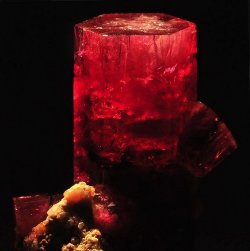
August Editorial
Red Beryl/Red Emerald

August Editorial
Red Beryl/Red Emerald
|
If you want a gemstone which is truly rare, don't look at diamonds. Though diamond dealers stockpile their diamonds to create an artificial scarcity, diamonds are actually a relatively common form of gemstone. Instead consider red beryls. Red beryl, which is also known as red emerald or bixbite may well be the rarest gemstone on Earth. It was first discovered in 1904 by the mineralogist Maynard Bixby (hence the bixbite name) at Maynard’s Claim in the the Thomas Range in Juab County, Utah. Maynard Bixby is also the discoverer of the manganese iron oxide which is known as 'bixbyite'. Because this name is so similar to bixbite, the name is seldom used for red beryl nowadays and has been deprecated from the CIBJO (the World Jewellery Confederation). The name 'red emerald' was introduced by jewelry marketers in 1970s but has now largely been dropped. So by default the gemstone is most commonly known today as 'red beryl'.
|
As the name indicates, red beryl is of the beryl family - beryllium aluminum cyclosilicate (Be3Al2SiO3). Pure beryl is colourless. The colour of different types of beryl results from traces of other minerals being present. In the case of red beryl the deep red colour comes from small amounts of manganese ions (Mn3+) along with traces of iron, chromium and calcium. Those minerals replace the aluminium in the beryl crystal structure giving the gem its distinct red colour. |
|
|
While most gem beryls are found in pegmatites (an intrusive igneous rock with very large crystals that forms in the later stages of a magma chamber's crystallization) and also in certain metamorphic stones, red beryl occurs in topaz (aluminium and fluorine silicate, Al2SiO4(F,OH)2)-bearing rhyolites (igneous, volcanic rock rich in silica). The red beryl deposits were created about 20 million years ago from volcanic vents. As the lava started to cool down, cracks were created which allowed the beryllium gasses to rise. When blown through the cracks, the gas was mixed with water, silica, alkali feldspar and iron-manganese oxides in a process which formed red beryl crystals. These crystals developed at low pressure and high temperature (300-600 celsius). There are very few known red beryl deposits . These are centered around the Wah Wah Mountains in Beaver County, Utah, in Juab County, Utah and in Sierra County, New Mexico. At present, there is no other location in the world where red beryl is found. Red beryl occurs in elongated hexagonal crystals that are about 2-10 mm long and 2-6 mm wide. Most red beryl crystals are very small and not gem quality. The best gem-grade crystals come from the Violet Claim in the Wah Wah Mountains. These retail for as much as $10,000 per carat. This is because crystals the size of 1 carat or larger are rare. To give an idea how rare red beryl is, consider this - approximately one crystal is found for each 150,000 diamonds mined. To date the largest red beryl crystal to be found was 14 mm by 34 ml and weighed 54 carats. The largest faceted red beryl weighs 8 carats. Compare that with the largest gem-quality diamond (the Cullinan diamond) which was 3106.75 carats when discovered, or the Golden Jubilee diamond (545.67 carats) which is the largest polished diamond. Recently red beryl has been occasionally confused with pezzottaite, a new type of mineral first recognised by the International Mineralogical Association in September 2003. Pezzottaite, named after Federico Pezzotta (the Italian mineralogist who discovered it), was first thought to be either red beryl or a new variety of beryl. However, chemical analysis of the mineral showed that pezzottaite is a cesium analogue of beryl with the chemical formula Cs(Be2Li)Al2Si6018. Pezzottaite has been found in Madagascar and more recently in Afghanistan. Red beryl and Pezzottaite can also be distinguished by their differing refractive index (for the definition of refraction and other optical properties of mineral see: 'Optical properties of rocks and minerals' article at this address: opticalprop.htm.) | |
| _______________________________ | ||||
| Home | | | Shopping | | | Database |
© Biscuit Software 2004-2015
All rights reserved